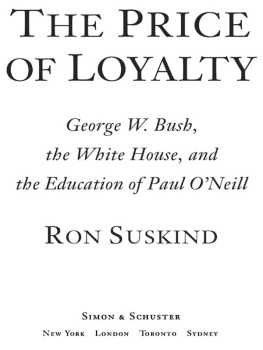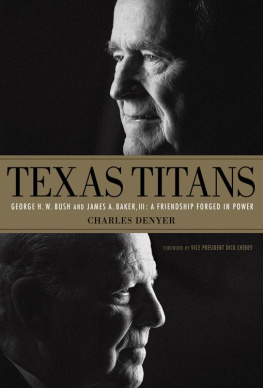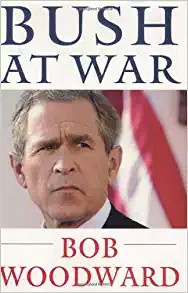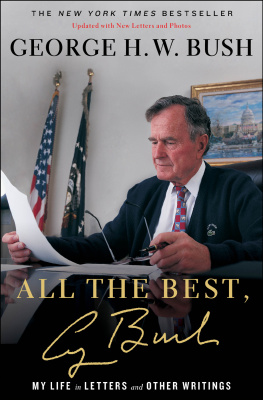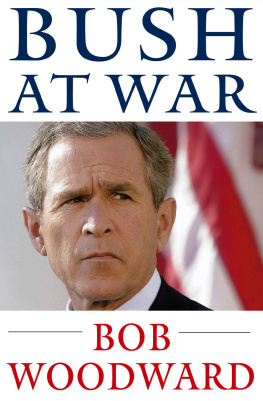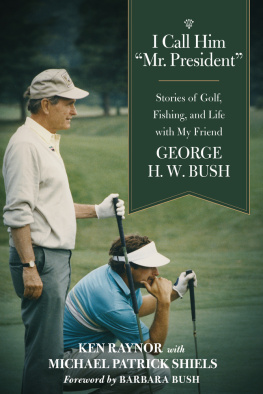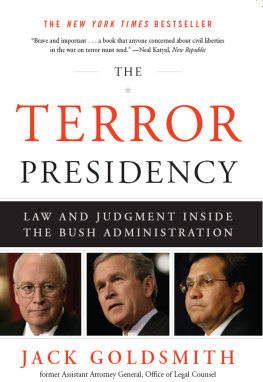SIMON & SCHUSTER and colophon are registered trademarks of Simon & Schuster, Inc.
Library of Congress Cataloging-in-Publication Data is available.
Authors Note
This is a work of narrative nonfiction, a form of writing about real events and people that relies on the power of story. The idea is that the telling of storiesnow, just as ten thousand years ago around the firehelps us make sense of ourselves and our world.
In this case, however, I think it is important for readers to be offered a glimpse of the machinery at work beneath the flow of episode, incident, and dialogue.
When this project officially began in February 2003, I was heartened, though not surprised, to find that Paul ONeill had a striking view of the value of secrecy that it had almost no value. We both happened to have read a 1998 book by Daniel Patrick Moynihan, a friend and mentor to ONeill, who wrote that twenty years on the Senate Select Committee on Intelligence had taught him a single, sterling lesson: The threat to our national security is not from secrets revealed, its from bad analysis. ONeill, with his affinity for assessing how process leads to outcome, often cited the separation of information into silosguarded as core assets by self-interested playersas one of the great obstacles to managing the huge, unwieldy American government. It has created an acute need for particularly skillful integratorsthose who can move freely among silos, pick and choose, and form connections to create a fabric of shared purpose.
With his extraordinary access to the President and so many silos of both domestic and foreign affairs, ONeill was a well-positioned integratorone of the few in this administration. It was an involvement that, in the end, nourished his insights and conclusions about the larger strugglesof policy versus politics and ideology versus analysisthat define this presidency and its role in the world.
The founding idea of this book is to grant readers a similar vantage point so they, too, can draw their own conclusions. ONeill agreed to this experiment in transparency and carried it through with his usual ardor. In February, he answered my request for his schedule with an extraordinary document. From the moment he was sworn into office to the final hour when he drove his car past the line of applauding staffers, each day is cataloged. There are 7,630 entries in the schedule, collected at the end of each day, including each meeting, those in attendance, the location, and the timeand a listing of every phone call, including who called whom and the length of the conversation.
That was just the start. In March, ONeill approached his former colleagues at the Treasury Department for what he insisted was his due: copies of every document that had crossed his desk. One day, as he was leaving Washington for Pittsburgh, he passed me a few unopened CD-ROMs. This is what they gave me, he said. When I started to open the disks, I wondered if there was an error on my hard drive: nineteen thousand documents were listed. They are image files, meaning that every document sent to ONeill was xeroxed. Those imagesan essential rendering of his two years as secretarycapture the activities of the full breadth of the U.S. government. They stretch from memoranda to the President to hand-scribbled thank-you notes, from minutes of meetings to hundred-page reports.
In March, I hired Alan Wirzbicki, a 2002 graduate of Harvard University and the former president of the Harvard Crimson as my assistant. He is a young man of capacious intellectual gifts and true grit. He dove into the documentsreading, categorizing, and filing each document in a retrievable formatand then began the process of assessing the worth of each. He also reported scenes for the book, analyzed a sweeping array of domestic and foreign issues, and worked, often, around the clock. His discretion, expertly honed, somehow, at the tender age of twenty-three, was invaluable. I could not have done this book without him.
I also benefitted from the assistance of countless people in the administration, from cabinet-level officials to executive assistants, who were cooperative. Many spoke off the recordthis was not a project, God knows, that was sanctioned by the administration. Others, however, spoke openly, encouraged, in many instances, by ONeills example. As Bono said in a chat we had in November, ONeill is amazingly loyalan old-fashioned thing, reallyand he inspires great loyalty in others. Thats because he looks at you as an equal; theres no arrogance there. He just wants to know what youre thinkingand he really listens. The people who are loyal to ONeill or to the ideal of transparencyand its corollary, informed consent of the governedgranted hundreds of hours of their precious time for interviews, offered notes from meetings, and unearthed illuminating recollections. Scenes were checked from many viewpoints. Dialogue was vetted by all sides. Documents, in an administration that has worked so fiercely to control what information becomes public, speak volumes.
Finally, there is ONeill himself. He has a stunning capacity to remember fine detail and broad stroke. He kept pads of personal notes, written in his speedy script, along with his own special files of papers and letters. And, as important as any document, any scrap of paper, is something that readers will notice on countless pageshis openness to describe what he felt day by day, moment by moment, including his doubts and frustrations and fears. This trust in honesty and disclosure is a virtue that animates every page of the book.
Which is why I let him read the finished manuscript to check for strictly factual errors. The few he spotted were corrected. His commitment to the accuracy of this book matches my own.
Total loyalty is possible only when fidelity is emptied of all concrete content, from which changes of mind might naturally arise.

